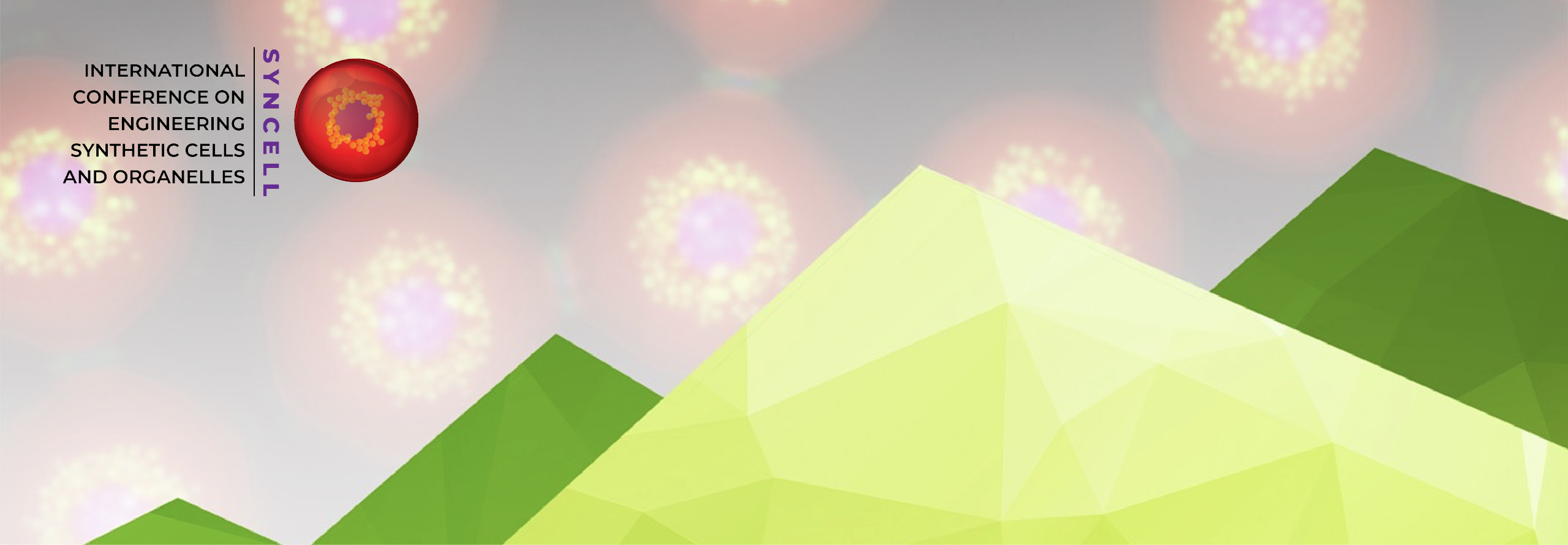
SynCell2021
Virtual Poster Session
Welcome to the content page for SynCell2021's virtual poster session. Here you will find presenter's posters and pre-recorded presentations to view from May 11-20 2021.
Vote for your favourite presentation by clicking the star ⭐️. The crowd's-choice presenter will be featured during our live event in a lightning ⚡️ round alongside the winner's of the poster competition.
Conference participants can interact with the poster presenters during our live event on 18 May 2021 during 2, 1-hour long sessions and on 19 May 2021 during one session. Links for the poster sessions to come. You can register for the conference webinar on our main website.
More info: https://syncell2021.unm.edu
Filter displayed posters (74 keywords)
Tracks
▼ 01. Syncells Back to top
Insights on the effect of cholesterol and sphingomyelin on tension and elasticity of plasma-like freestanding model membranes from natural lipids
Alessandra Griffo*, Carola Sparn, Friederike Nolle, Jean-Baptiste-Fleury, Ralf Seeman, Walter Nickel, Hendrik Hähl*
Light-activated gene expression in synthetic cells
Jefferson M. Smith*, Denis Hartmann, Michael J. Booth
Light-activated DNA is constructed by introducing 7 amino C6 thymine bases that are conjugated to photocleavable biotinylated linkers into the T7 promoter of a linear DNA template. Monovalent streptavidin binds at each biotin and sterically hinders transcription of the downstream gene by RNA polymerase in the absence of light. However, after UV irradiation, the photocleavable linker-streptavidin complex is liberated and transcription/translation can proceed. Using this approach, we have demonstrated that protein expression inside giant unilamellar vesicles can be activated using light as an external stimulus and using we can control this spatiotemporally using pattern illumination. Using this platform, we established a means to mediate synthetic cell-bacteria cell communication through the controlled in-situ synthesis of acyl homoserine lactones involved in quorum sensing.
Biomimetic rebuilding of multifunctional red blood cells
Jimin Guo
A minimal pathway for the regeneration of redox cofactors
Michele Partipilo, Eleanor J. Ewins, Jacopo Frallicciardi, Tom Robinson, Bert Poolman & Dirk Jan Slotboom
Single compartment approach for photo-autotrophic protocell preparation
Altamura E., Albanese P., Milano F., Giotta L., Trotta M., Ferretta A., Cocco T., Mavelli F.
Influence of Breast Cancer Lipid Changes on Membrane Oxygen Permeability
Qi Wang, Rachel J. Dotson, Gary Angles, Sally C. Pias
Chemoselective generation of dynamic synthetic cells
Roberto J. Brea, Neal K. Devaraj
▼ 02. Synthetic Genomes Back to top
Genetic circuits based on serine-integrases as regulatory networks in the minimal cell Mycoplasma mycoides JCVI-Syn3A
Marco A. de OLIVEIRA¹,², Daniela BITTENCOURT², Yo SUZUKI³, John I. GLASS³, Elibio L. RECH²
▼ 03. Synthetic Organelles Back to top
Lipid Sponge Droplets as Programmable Synthetic Organelles
Ahanjit Bhattacharya, Neal K. Devaraj
Chemoenzymatic Generation of Phospholipid Membranes Mediated by Type I Fatty Acid Synthase
Satyam Khanal, Michael D. Burkart, Neal K. Devaraj
Recombinant Intrinsically Disordered Proteins for Triggered Sequestration of Nucleic Acids via Liquid-Liquid Phase Separation
Telmo Díez Pérez, Jacqueline A. De Lora, Adam D. Quintana, Andrew P. Shreve, Gabriel P. López, Nick J. Carroll
▼ 04. Compartmentalization Back to top
Pure protein bilayers and vesicles made from fungal hydrophobins: an alternative platform for synthetic cells
Hendrik Hähl, Friederike Nolle, Alessandra Griffo, Kirstin Kochems, Päivi Laaksonen, Michael Lienemann, Ralf Seemann, Jean-Baptiste Fleury, and Karin Jacobs
[1] Hähl, H. et al., Langmuir 34, 8542 (2018). [2] Hähl, H. et al., Adv Mater 29, 1602888 (2017).
Charge vs. SNARE-mediated fusion of biomimetic polymer/lipid hybrid compartments: Which one is more efficient?
Nika Marušič1, Lado Otrin1, Ziliang Zhao2, Fotis L. Kyrilis3, Farzad Hamdi3, Panagiotis L. Kastritis3, Rumiana Dimova2, Tanja Vidaković-Koch1, Ivan Ivanov1, Kai Sundmacher1
Generation of Extracellular Matrix Protein-based Microcapsules for Investigating Single Cells
Sadaf Pashapour, Ilia Platzmann, Friedrich Frischknecht and Joachim P. Spatz
Tetraspanin Scaffold Regulation of Epidermal Growth Factor Receptor Biology on the Plasma Membrane
Sebastian Restrepo Cruz, Sandeep Pallikkuth, Keith A. Lidke, Diane S. Lidke, and Jennifer M. Gillette
Monitor, categorize and manipulate label-free water-in-oil droplets in microfluidic systems
Tobias Neckernuss, Christoph Frey, Jonas Pfeil, Daniel Geiger, Patricia Schwilling, Ilia Platzman, Joachim Spatz and Othmar Marti
▼ 05. Astrobiology Back to top
Hydrodynamically-active oily ocean surface as a cradle for the emergence of life
Franky Djutanta, Rachael Kha, Bernard Yurke, and Rizal F. Hariadi
▼ 06. Synthetic Signalling Back to top
Building mechanosensitive signalling pathways in synthetic cells using membrane engineering
James W. Hindley, Yuval Elani, Robert V. Law, Oscar Ces
▼ 07. Synthetic Proteins Back to top
Engineering High Throughput Biosynthesis of Natural Product-Like Cyclic Peptides
Jillian Stafford and Mark C. Walker


















